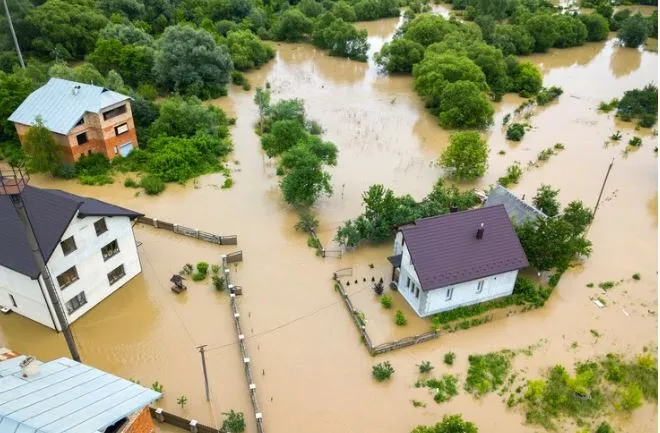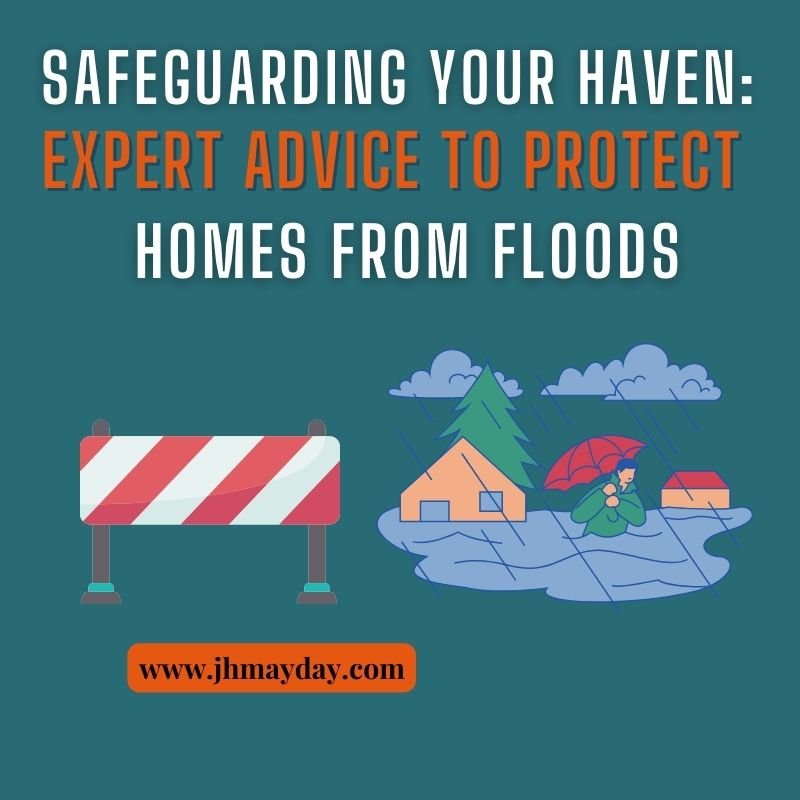In the face of nature’s mighty force, our homes stand as beacons of security and comfort. Yet, floods, with their relentless power, pose a significant threat to the sanctity of our dwellings. As an expert in flood mitigation and armed with a repertoire of practical wisdom, I am delighted to share invaluable advice on protecting your cherished abode from the ravages of floodwaters. Join me on this journey as we explore effective strategies, practical tips, and creative solutions to fortify your home against the surging tides.

1. Understand Your Environment: Know the Battlefield
To build a resilient fortress, one must first understand the battlefield. Start by studying flood maps and consulting local authorities to ascertain the flood risks specific to your area. Additionally, consider factors such as nearby bodies of water, drainage systems, and historical flood data. This knowledge will empower you to make informed decisions about flood protection measures and preparedness.
2. Elevate Essential Systems: Above the Reach of Floodwaters
Protecting your home’s vital systems is paramount in flood mitigation. Consider elevating electrical panels, heating, ventilation, and air conditioning (HVAC) units, and water heaters above the anticipated flood levels. By raising these critical components, you create a safeguard against potential damage and ensure the safety and functionality of your home’s infrastructure during and after a flood event.
3. Secure Basement Vulnerabilities: Reinforce the Last Line of Defense
Basements, being the lowest point of your home, are particularly susceptible to flooding. To fortify this vulnerable area, apply waterproof coatings to basement walls and floors, sealing any existing cracks or gaps. Installing a reliable sump pump with a battery backup system is also crucial, as it swiftly removes water and prevents excessive buildup during heavy rainfall or rising groundwater levels.
4. Embrace Landscaping as a Shield: Nature’s Defense Mechanism
Strategic landscaping can transform your property into a fortress against floodwaters. Consider planting native vegetation, creating swales or berms, and building terraces to redirect water flow away from your home. Additionally, installing rain gardens or French drains can absorb and retain excess rainfall, reducing runoff and lessening the risk of flood damage.
5. Enhance External Barriers: Strengthen Your Home’s Armor
Your home’s exterior must be fortified to ward off the encroaching floods. Seal foundation cracks using specialized sealants or waterproofing membranes to prevent water seepage. Invest in flood-resistant doors and windows that are designed to withstand the force of floodwaters. For added protection, consider installing flood shields or barriers, such as removable flood panels or inflatable barriers, that can be deployed quickly when a flood threat looms.
6. Waterproof Valuables and Essentials: Preserving Sentimental Treasures
Preserving cherished possessions is as essential as safeguarding the physical structure of your home. Store important documents, photographs, and sentimental items in waterproof and elevated containers. Utilize plastic bins with secure lids or invest in specialized waterproof safes. These measures will provide an extra layer of protection, ensuring that your valued possessions remain unscathed in the event of a flood.
7. Reinforce Utilities: Keep the Lifelines Intact
Floods can disrupt crucial utilities, leaving us vulnerable and disconnected. Fortify utility systems by raising electrical outlets, switches, and wiring above flood levels. Consider installing check valves in your plumbing system to prevent sewage backflow during flooding. Furthermore, invest in battery-powered backup systems for sump pumps, as they ensure continued operation even in the absence of electricity.
8. Create an Emergency Plan: Ready for Action
A well-prepared household is a resilient one. Develop a comprehensive emergency plan that includes evacuation routes, designated meeting points and a communication strategy. Educate all family members about emergency procedures, including how to safely shut off utilities and access emergency supplies. Ensure that necessary supplies, including a disaster kit stocked with essentials such as food, water, medications, and first aid supplies, are readily available and regularly replenished.

9. Secure Insurance Coverage: Financial Preparedness
While prevention is crucial, it is wise to be financially prepared for unforeseen events. Review your homeowner’s insurance policy to ensure it adequately covers flood damage. Standard policies often exclude coverage for floods, so consider purchasing separate flood insurance. Consult an insurance professional to understand the options available for your specific needs, ensuring that your home and belongings are adequately protected.
10. Stay Informed and Prepared: Knowledge is Power
Maintaining awareness of your surroundings is vital for timely action. Stay updated on weather forecasts, flood alerts, and emergency notifications in your area. Invest in a weather radio or utilize smartphone apps that provide real-time alerts for severe weather conditions. By staying informed and prepared, you can swiftly respond to potential threats and protect your home effectively.
11. Install Flood Alarms: Early Warning Systems
Early detection of rising water levels is crucial in mitigating flood damage. Install flood alarms or water level sensors in areas prone to flooding, such as basements or low-lying areas. These devices can alert you when water levels reach a critical point, giving you valuable time to take preventive measures or evacuate if necessary.
12. Maintain Gutters and Downspouts: Keep the Water Flowing
Proper maintenance of gutters and downspouts is essential in preventing water buildup around your home’s foundation. Regularly clean and clear debris from gutters to ensure unobstructed water flow. Consider installing gutter guards to prevent clogs and redirect water away from the foundation. Ensure downspouts are positioned to discharge water at least five feet away from your home.
13. Elevate Outdoor Equipment: Protect Your Investments
Outdoor equipment such as air conditioning units, generators, and fuel tanks are susceptible to flood damage. Elevate these items on raised platforms or concrete pads to keep them above potential floodwaters. Consult with a professional to ensure proper installation and anchoring to withstand strong currents.
14. Create a Rainwater Harvesting System: Utilize Nature’s Bounty
Turn the tables on floodwaters by harnessing the power of rain for a positive purpose. Install a rainwater harvesting system that collects and stores rainfall for later use. By diverting excess water into storage tanks or barrels, you not only reduce the risk of flooding but also have a sustainable water source for gardening and non-potable household needs.
15. Foster Community Preparedness: Strength in Unity
Engage with your neighbors, local authorities, and community organizations to promote flood awareness and preparedness. Share knowledge, experiences, and resources to collectively strengthen resilience within your community. Consider organizing workshops or neighborhood initiatives to educate others on flood safety and mitigation strategies.
16. Regular Inspections and Maintenance: A Preventive Approach
Schedule regular inspections of your home’s foundation, walls, and plumbing systems to detect any signs of damage or vulnerability. Address issues promptly, such as cracks in the foundation or deteriorating seals around windows and doors. Stay vigilant and conduct routine maintenance, such as cleaning and servicing sump pumps, to ensure their optimal functionality.

17. Practice Wise Land Use: Build Responsibly
If you’re constructing a new home or renovating an existing one, consider flood-resistant design principles. Work with architects and builders who understand flood mitigation techniques and can implement measures such as raised foundations, flood-resistant materials, and proper drainage systems. Ensure compliance with local building codes and regulations to minimize flood risks.
18. Keep Emergency Contact Information Handy: Be Prepared to Act
Maintain a list of emergency contact numbers, including local authorities, utilities, insurance providers, and restoration services. Keep this information readily accessible in case of an emergency. Having it at your fingertips will enable you to take swift action and seek assistance when needed.
19. Learn from Past Flood Experiences: Adapt and Improve
Reflect on past flood experiences, whether in your home or community, and identify areas for improvement. Take note of any weaknesses in your flood protection measures or emergency response. Use these lessons as opportunities to adapt and strengthen your defenses, continuously improving your ability to mitigate future flood risks.
20. Seek Professional Guidance: Expert Advice Matters
When it comes to protecting your home from floods, seeking professional guidance can provide invaluable insights and peace of mind. Consult with flood mitigation specialists, architects, or engineers who specialize in flood-resistant design and retrofitting. Their expertise can help you identify specific vulnerabilities and develop customized solutions tailored to your home’s unique characteristics.
Conclusion:
Safeguarding your home from floods requires a multifaceted approach, combining practical measures, thoughtful planning, and continuous adaptation. By implementing these tips and advice, you can significantly minimize the potential damages caused by floods. Remember, proactive measures, such as understanding your environment, elevating essential systems, reinforcing vulnerable areas, and staying informed, are the keys to protecting your haven and ensuring the safety and well-being of your loved ones.

